TerraMaster F2-221 2-Bay NAS Performance
Our TerraMaster F2-221 can be set up to run in several different configurations, RAID 0, 1, and JBOD or as a single disk. For our testing, we built the F2-221 with each different RAID type available for a typical two drive NAS. Before we continue testing we allowed each RAID type to finish its synchronizing process.
Intel NAS Performance Toolkit
The Intel NAS Performance Toolkit (Intel NASPT) is a file system exerciser and analysis tool designed to enable performance comparisons between network-attached storage (NAS) devices.
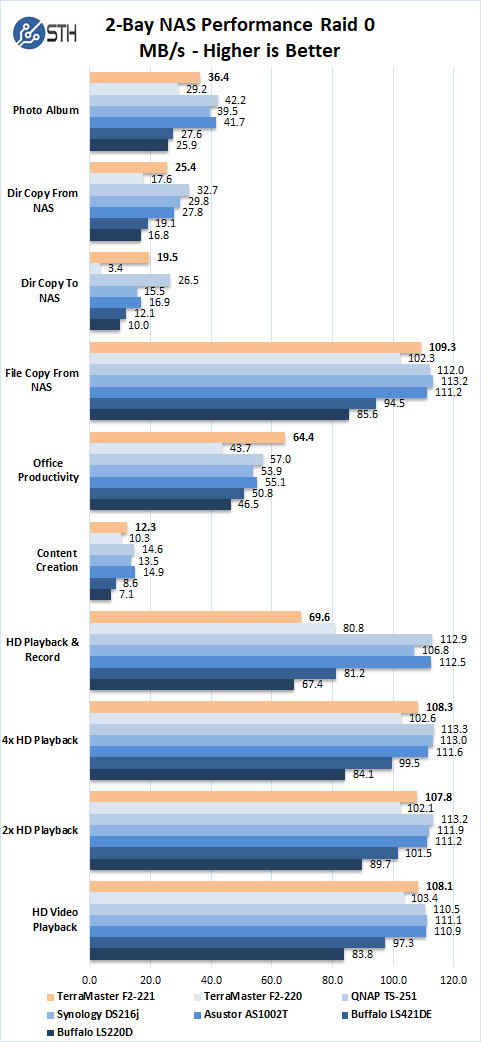
Here we see the results of our RAID 0 tests, in this set the F2-221 performs better in almost all results vs. the F2-220 and Office Productivity takes the lead.
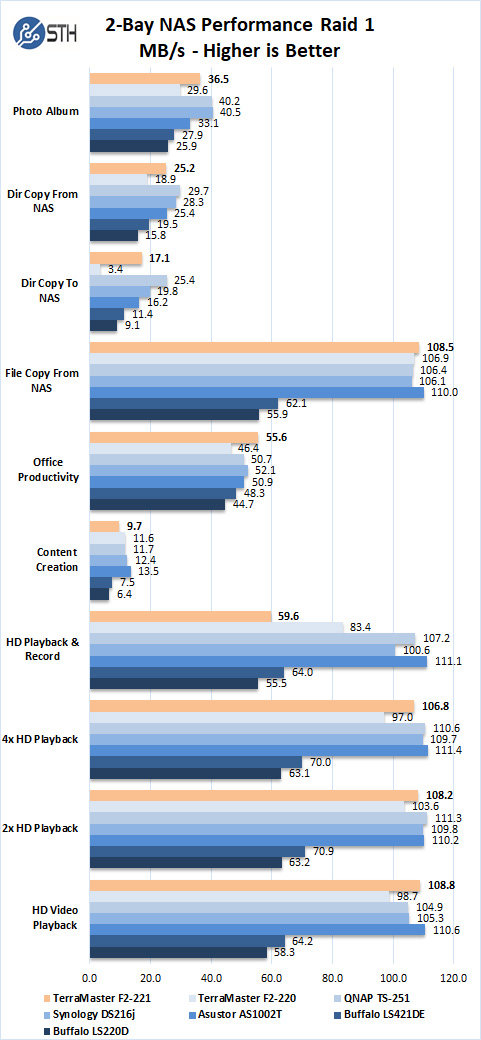
In our RAID 1 tests, we see better results which boost our results to compete with other units, except for HD Playback and Record.
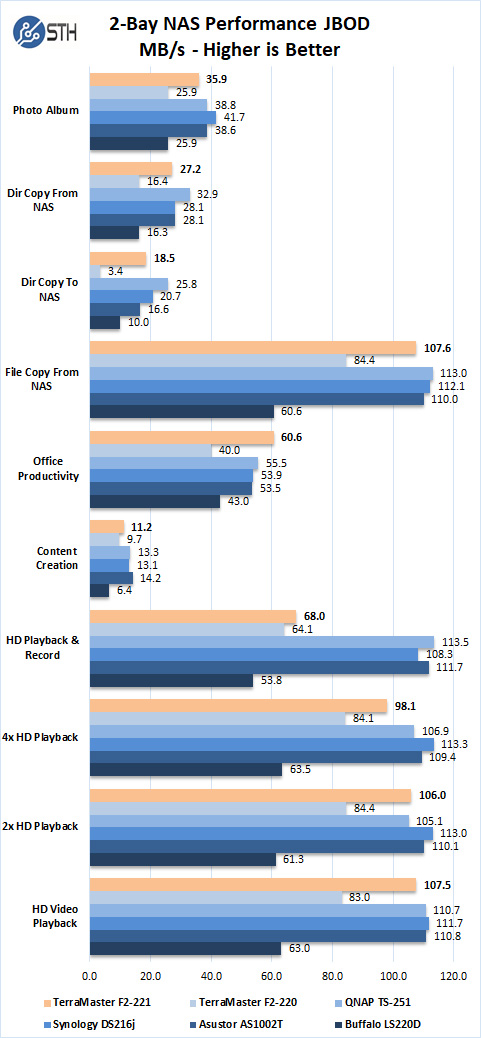
In the JBOD tests, competes very well and is a better performer vs. the F2-220.
Encrypted Benchmarks
We also ran Encrypted benchmarks on our F2-221. With this NAS you can only Encrypt Shares. In encrypted benchmarks, we find the new Intel Celeron J3355 is far superior in encryption than the older 2-Bay NAS’s we have tested before.
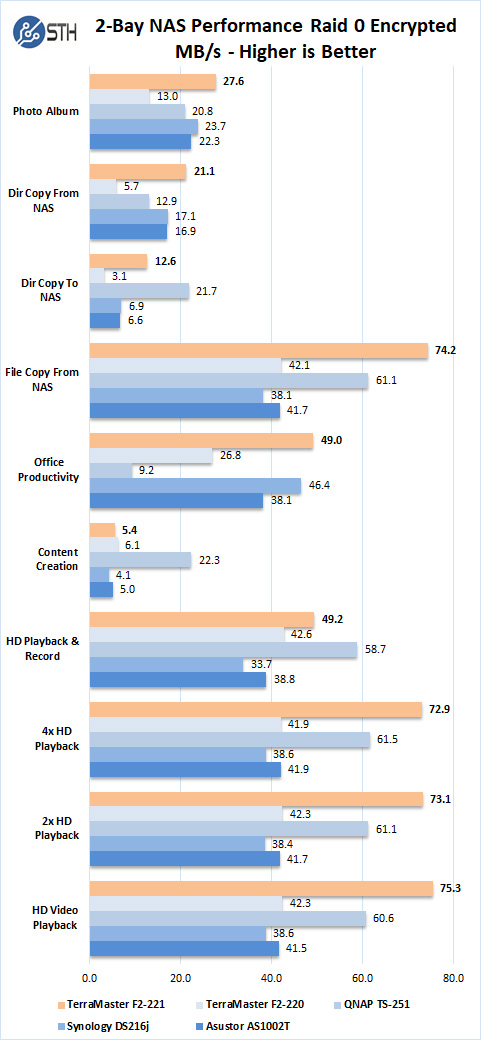
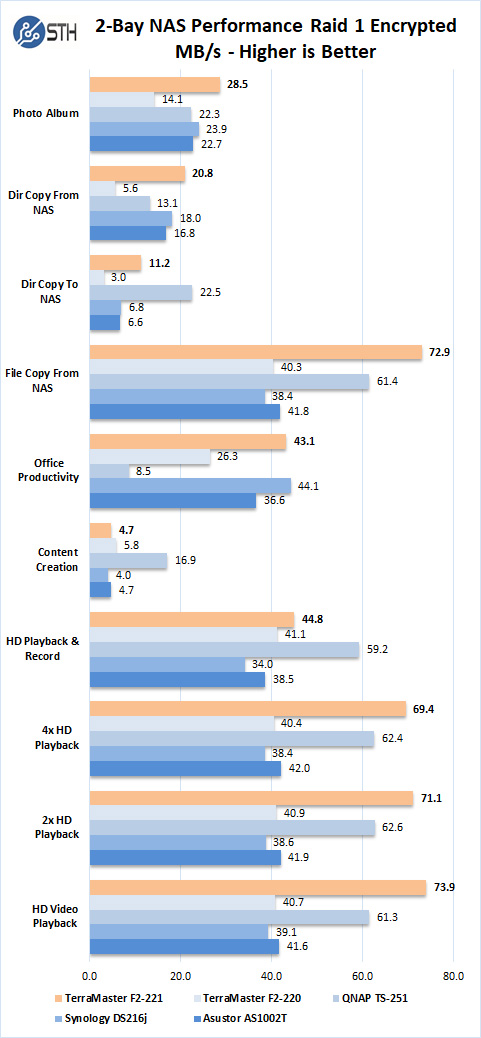
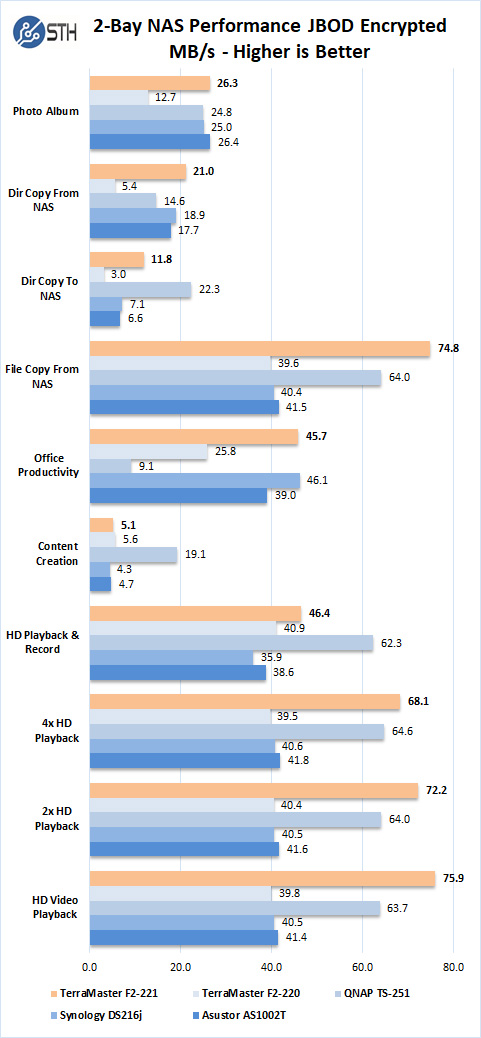
The F2-221 takes off with encryption vs. the other NAS’s we have tested, in some cases, it has double the performance of the set we have tested. You can clearly see the crypto acceleration at work here when you compare the F2-221 with the older F2-220.
Conclusion
We have to admit that we were not expecting much with the F2-221, sure it added an extra 1Gbe LAN port and replaced the mix of USB ports from the previous model with two USB 3.0 ports, these features bring the F2-221 inline with other 2-Bay NAS’s on the market. But the real gem of the F2-221 is the new Intel Celeron J3355 that TerraMaster used, this processor can chew up past NAS’s we have used in Encryption, in some cases double the performance which is outstanding. The memory loadout is also typical for most NAS’s with 2GB installed, TerraMaster took this a step further by making this upgradable to 4GB for those that need to run a few extra applications. 2GB of RAM is sufficient for many users, but being able to expand that is a big plus. Also worth noting, the F2-221 uses DDR4 instead of DDR3 used on the F2-220.
TerraMaster did not stop with just upgrading the hardware; the new TOS 4.0 is smoother in operation, improved snapshots for backups and faster 4K Ultra HD Video Transcoding.
A quick scan online shows the F2-221 2-Bay NAS is available for around a $260-270 street price which is a bit pricey for a 2-bay unit. However, most other results in the 2-Bay NAS search are older units with sub-performance. If encryption is high up on your list and you require that extra protection take a look at the TerraMaster F2-221 2-Bay NAS.




That logo looks like a CoolerMaater logo ripoff.
The device looks nice though.
I have the Terramaster F4-220 that I got on a Newegg flash sale for $189 shipped. I think for the money, it is a good unit, but I do find TOS 4 to be lacking in some features, such as the ability to use rsync modules without authentication. This made for quite the hair-pulling experience as I purchased this device to backup data from my main storage server, which is a semi-custom freenas build. Due to the Terramaster unit requiring authentication for either rsync over SSH or rsync modules and the lack of the ability to define SSH credentials when creating a rsync tasks in freenas, a workaround must be found. I initially generated shared SSH keys between the freenas and terramaster units but found that much like freenas, the SSH keys are erased every time the unit is power cycled. It also took me a while to figure out that the name of the rsync module for the TerraMaster unit is the name of the datastore that you create during the initial configuration. Since you cannot disable rsync module authentication, I ended up having to create a separate datastore in freenas that stored the rsync credentials in a plain text file and then referenced the credentials file in the custom commands section of the rsync task creation GUI. It may sound simple enough but this took me probably 10 hours to figure out in total.
I ended up decommissioning the unit and moved the drives into a Hyve Cygnus server that I bought off of eBay for the same amount of money. It is a much more powerful server and holds 12 x 3.5 inch drives in a 1u chassis. It also allowed me to install a 10 gigabit card and run freenas. It is quiet, has a virtual console, and supports much higher speeds for both iops and sequential transfers. I would highly recommend looking into one of these if you are space confined and looking for a standalone storage server.
Some people have had success installing xpenology on the terramaster units, however, is still quite limited in its utility with such a low power processor and a single gigabit port. I also noticed that the drives ran extremely hot in the terramaster unit. When I first pulled them out to transfer them into my other server, they were so hot that I had to let them sit in their trays for a while and cool down. I’m not sure that the Terramaster units are adequately cooling drives. This might warrant further research on STH’s part.